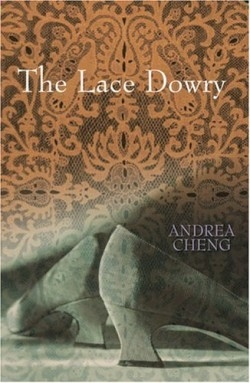
The Lace Dowry
In this novella, it is a truth universally acknowledged that a single woman in possession of a good fortune must be in want of a dowry. Unfortunately, Juli wants to be alone with her books, and thinks that amassing household goods for a bride is a completely outdated idea for a young woman growing up in Budapest between the World Wars. Besides, she’s only twelve years old. Her mother arranges a dowry for her anyway, including one of the largest pieces of lace ever commissioned. Juli soon finds herself on a train bound for the village of Halas, where farm women painstakingly ply their needles on the intricate webs for which they were justly famous.
The girl initially finds it hard to match her mother’s excitement about the process, but over bimonthly trips to check on the tablecloth’s progress, Juli becomes friends with the lace maker’s daughter, Roza. Juli idealizes Roza’s life on the farm, comparing it favorably to Juli’s own growing friction with her parents.
As Juli begins to comprehend the hardships that the Halas lace makers face, she struggles even harder against her mother, who seems oblivious to Juli’s own feelings and wishes. The girl’s defiance of her parents in order to help Roza catalyzes a confrontation in which Juli finally comes to understand her mother’s insistence on the dowry and her hopes for her daughter. Caught between childhood and the adult realities that the dowry represents, Juli and her mother grow to realize that they will have to treat each other with respect as they navigate their relationship.
The Lace Dowry creates a woman’s world, a picture of life in Hungary during the early twentieth century as seen by the female characters who carry the plot. While too brief to be a true coming-of-age story, the book presents a well-drawn portrait of mothers and daughters, as Juli and Roza approach young adulthood. The historical context helps define these relationships more strongly.
The author, the daughter of Hungarian Jewish immigrants, grew up speaking mostly Hungarian at home. She has published an impressive list of books for children and young adults, many with historical contexts and cross-cultural themes, including Marika and the award-winning Grandfather Counts. Her fascinating Author’s Note at the end of this novella describes how her grandmother commissioned a lace tablecloth from the Halas lace makers for her own daughter’s dowry. The tablecloth remains with Cheng’s family and is reportedly one of the largest and most exquisite examples of Halas lace making in existence.
This fictional story was also inspired by the real women in Cheng’s family. Hungary between the World Wars is an unusual backdrop for historical fiction, and Cheng’s novella gives a tantalizing glimpse of the period. The combination of educational content and entertainment in The Lace Dowry should please teachers, parents, and young readers alike.
Reviewed by
Johanna Massé
Disclosure: This article is not an endorsement, but a review. The publisher of this book provided free copies of the book to have their book reviewed by a professional reviewer. No fee was paid by the publisher for this review. Foreword Reviews only recommends books that we love. Foreword Magazine, Inc. is disclosing this in accordance with the Federal Trade Commission’s 16 CFR, Part 255.
